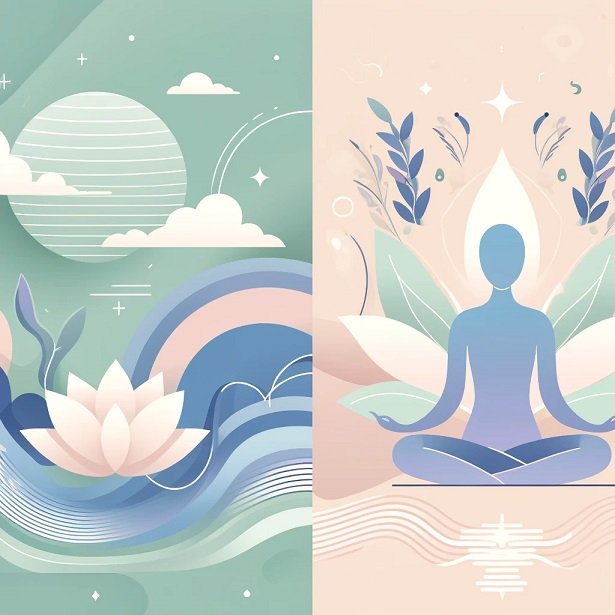
Embark on a journey towards inner peace with this step-by-step guide to crafting a mindful meditation routine. By following these gentle steps, you can cultivate a practice that nurtures your mind, body, and soul. Let’s begin this transformative process together, one mindful breath at a time.
Preparing for Mindfulness
Creating a Conducive Environment
To cultivate a successful mindfulness practice, it is important to create a conducive environment that supports tranquility and focus. Find a quiet space in your home where you can sit comfortably without distractions. Consider adding elements that enhance relaxation, such as candles, cushions, or soothing music. Keep the space tidy and free of clutter to promote a sense of peace and openness for your practice.
Setting Realistic Expectations
An important aspect of preparing for mindfulness is setting realistic expectations for yourself. Understand that mindfulness is a skill that develops over time with consistent practice. Be patient and gentle with yourself as you begin your meditation routine. It is normal to experience wandering thoughts or restlessness – acknowledge these moments without judgment and gently guide your focus back to the present moment.
Expectations:
Establishing a Daily Habit
Little by little, we can cultivate a daily meditation practice that nourishes our mind, body, and soul. One of the key aspects of creating a mindful meditation routine is committing to a regular time and place for your practice.
Choosing a Regular Time and Place
Choosing a specific time and place for your meditation practice can help anchor it into your daily routine. Whether it’s first thing in the morning before the hustle and bustle of the day begins, during your lunch break to recenter, or in the evening to unwind, find a time that works best for you. Similarly, selecting a quiet and peaceful spot in your home or a favorite outdoor location can enhance your meditation experience. Create a sacred space that invites stillness and tranquility, making it easier to slip into a meditative state.
Developing a Consistent Routine
Place your meditation practice at the top of your priority list to ensure consistency. Make a commitment to yourself to show up for your practice each day, even if it’s just for a few minutes. Consistency is key in establishing a habit, so treat your meditation time as a non-negotiable appointment with yourself. For instance, you can set a gentle reminder on your phone or use visual cues like leaving your meditation cushion in plain sight to encourage regular practice.
Cultivating Awareness
One of the key aspects of mindfulness meditation is learning to cultivate awareness. This involves paying attention to the present moment with openness and acceptance. By developing awareness, you can observe your thoughts, emotions, and sensations without judgment.
Focusing on the Breath
For beginners, focusing on the breath is a great way to anchor your attention and cultivate mindfulness. Start by sitting or lying in a comfortable position. Close your eyes and bring your attention to the sensation of your breath entering and leaving your body. Notice how your chest or abdomen rises and falls with each breath. If your mind wanders, gently bring your focus back to your breath without judgment.
Noticing Body Sensations
Focusing on body sensations is another powerful way to cultivate awareness during meditation. Bring your awareness to different parts of your body, starting from your head down to your toes. Notice any tension, warmth, or tingling sensations without trying to change them. By observing these physical sensations, you can deepen your connection to your body and the present moment.
Focusing on body sensations can help you become more attuned to how your body responds to stress, emotions, and various stimuli. By tuning into these sensations without reacting, you can develop a greater sense of self-awareness and learn to respond to situations more mindfully.
Observing Thoughts and Emotions
Another important aspect of cultivating awareness in meditation is observing your thoughts and emotions. As you meditate, pay attention to the thoughts that arise in your mind without getting caught up in them. Notice any emotions that surface, such as joy, sadness, or frustration. By observing these thoughts and emotions with curiosity and compassion, you can gain insight into your inner landscape and cultivate a greater sense of emotional intelligence.
Breath can serve as an anchor when observing thoughts and emotions. Just like with body sensations, you can use your breath to stay grounded and present as you observe the thoughts and feelings that come and go in your mind.
Working with Distractions
Dealing with Mental Chatter
Not every meditation session will be a serene experience. One common challenge that many practitioners face is dealing with mental chatter. As you sit down to meditate, your mind might start racing with thoughts about your to-do list, worries, or memories. Instead of fighting these thoughts, try to observe them with curiosity and non-judgment. Acknowledge their presence and then gently guide your focus back to your breath or mantra. Keep in mind, the goal is not to stop your thoughts completely but rather to cultivate a sense of inner peace amidst the mental noise.
Managing Physical Discomfort
Working through physical discomfort during meditation can be tough, but it’s an excellent opportunity to practice mindfulness and acceptance. Noticing sensations like tingling, stiffness, or even pain in your body is a chance to develop resilience and tranquility. If you’re feeling uncomfortable, try adjusting your posture slightly or gently stretching to release tension. Remember that discomfort is temporary and a natural part of the meditation process. Embrace it with compassion and use it as a tool to deepen your practice.
A mindful approach to physical discomfort can help you build patience and resilience both on and off the meditation cushion. By learning to observe and accept these sensations without judgment, you can cultivate a greater sense of peace and equanimity in your daily life.
Coping with External Distractions
External distractions, such as noisy neighbors, honking cars, or household sounds, can make it challenging to stay focused during meditation. When faced with these disturbances, try to incorporate them into your practice rather than resist them. External distractions can serve as anchors to the present moment, inviting you to embrace them with openness and curiosity. Instead of becoming frustrated, view these interruptions as opportunities to strengthen your mindfulness skills and deepen your practice.
Managing external distractions during meditation is a powerful way to transcend external circumstances and cultivate a deeper sense of inner calm and resilience. By observing these interruptions without attachment or aversion, you can harness them as tools for greater self-awareness and presence.
Deepening Your Practice
Many individuals find that as they continue on their meditation journey, they may wish to research deeper into their practice to enhance their overall experience. This can involve exploring different techniques and styles of meditation to find what resonates most with you.
Exploring Guided Meditations
Your meditation routine can benefit from integrating guided meditations. These sessions are led by experienced teachers or through audio recordings that offer verbal cues and imagery to guide you through the practice. Guided meditations can help you stay focused, relax, and deepen your connection to the present moment, making them a valuable tool for those looking to enrich their meditation routine.
Incorporating Loving-Kindness Meditation
On your mindfulness journey, you may want to include loving-kindness meditation in your routine. This practice involves directing feelings of love, compassion, and goodwill towards yourself and others. By incorporating loving-kindness meditation into your sessions, you can cultivate a sense of compassion and kindness towards yourself and others, enhancing your overall well-being and deepening your spiritual practice.
Another way to deepen your meditation practice is by using visualization techniques. Visualization involves creating mental images that promote relaxation, focus, and mindfulness during your meditation session. By incorporating visualization into your routine, you can enhance your ability to center yourself, reduce stress, and tap into your inner creativity and intuition.
Using Visualization Techniques
Guided visualization techniques can be especially helpful for beginners or those struggling to maintain focus during meditation. These techniques often involve visualizing peaceful scenes or positive affirmations to help calm the mind and enhance the meditation experience.
With dedication and patience, you can explore these different methods to deepen your meditation practice and cultivate a greater sense of mindfulness and tranquility in your daily life.
Overcoming Common Obstacles
Dealing with Frustration and Impatience
After you’ve started your mindful meditation routine, it’s common to encounter feelings of frustration and impatience, especially if you don’t see immediate results. Remember that meditation is a practice that requires patience and perseverance. One way to deal with these feelings is to acknowledge them without judgment. Allow yourself to feel frustrated or impatient, but gently guide your focus back to your breath or mantra. Embrace the process, knowing that each moment of mindfulness contributes to your overall well-being.
Overcoming Sleepiness and Fatigue
Impatience can arise during meditation when you feel restless or keyed up. To counter this, try incorporating shorter meditation sessions throughout the day to keep your practice consistent. It’s alright to start with just a few minutes and gradually increase the duration as you feel more comfortable. Additionally, you can experiment with different meditation techniques to find what works best for you, whether it be focused breathing, body scans, or guided imagery.
Overcoming sleepiness and fatigue while meditating can be a common challenge, especially if you are practicing at the end of a long day or early in the morning. To combat this, make sure you are well-rested before your meditation session. If you find yourself nodding off, try meditating in a seated position with your spine straight, or incorporate gentle movement like stretching before sitting down to meditate.
Managing Self-Doubt and Criticism
One of the obstacles that may arise during your meditation practice is self-doubt and self-criticism. The key is to practice self-compassion and remind yourself that it’s okay to have doubts or critical thoughts. Instead of pushing these feelings away, acknowledge them and then gently redirect your focus back to the present moment. Remember that meditation is a journey, and it’s natural to have moments of uncertainty. By cultivating self-acceptance and kindness, you can navigate through these challenges with grace and ease.
Final Words
Ultimately, creating a mindful meditation routine is a journey towards inner peace and self-discovery. By following the step-by-step guide provided, you can cultivate mindfulness, reduce stress, and enhance your overall well-being. Remember to approach your practice with patience, kindness, and non-judgment, allowing yourself to fully embrace each moment as it comes. The key is consistency and commitment to your practice, even on days when it may feel challenging. Trust that with time and dedication, you will experience the transformative power of mindfulness in your life.
